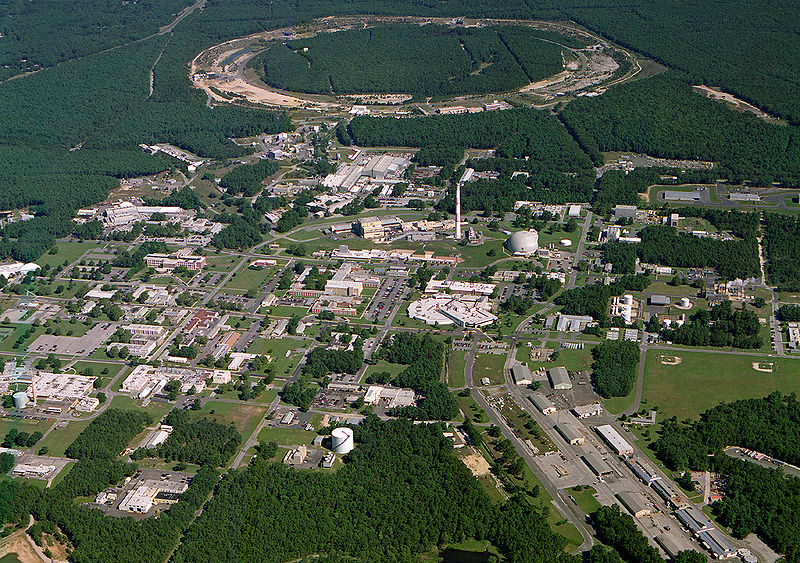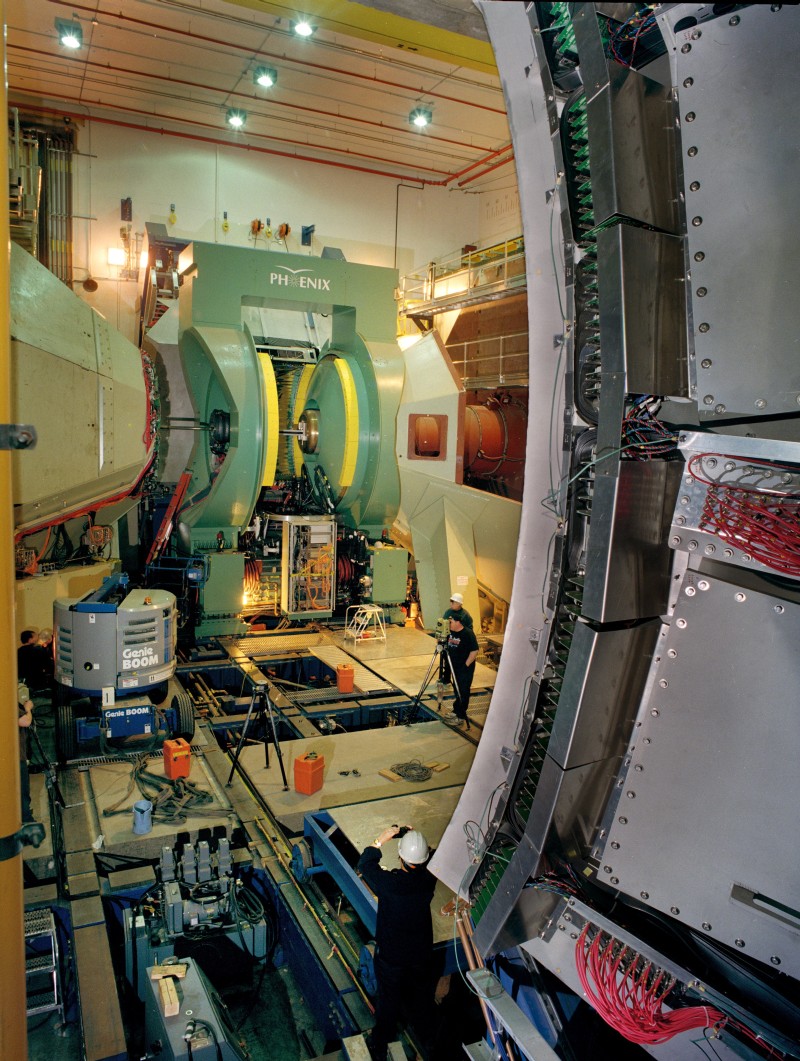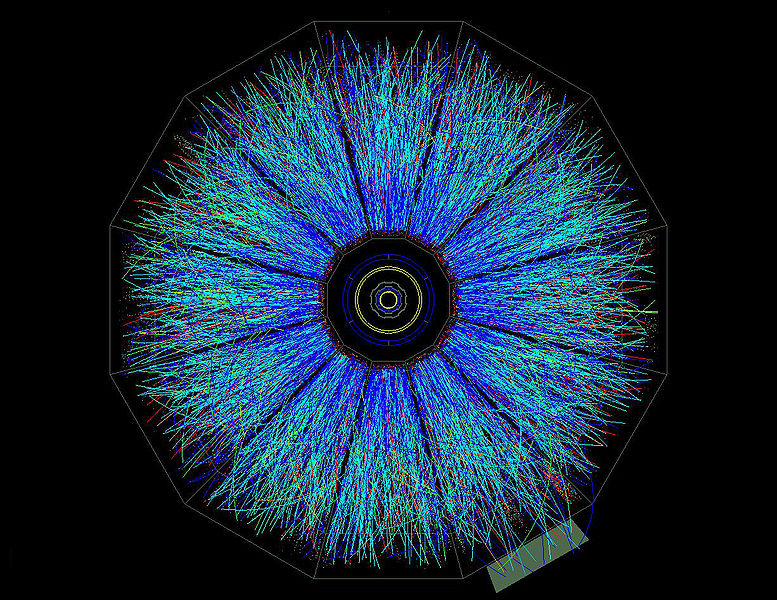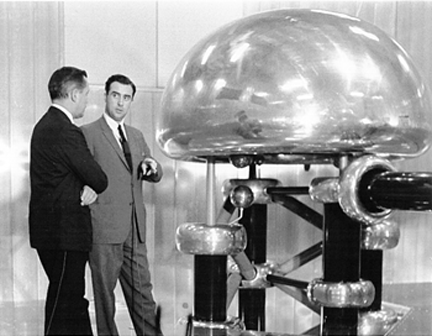Added 1 new A* page:Hello! Darn these Mondays and all. :P
Changing the topic to another day, then, over the weekend I added an update to my long-lost series of odd little visual font poem things, "word." So yes it is a little poem, but I did manage to work "Doppler shift" into it, which I was reasonably happy with, as I'm sure you can imagine. Man! So anyway if you want to see what that noise is all about, you can get right to it by clicking on this grayish banner thingy:

~~~~~
Here's something that's pretty neat, though! Just today, an article came out saying that scientists using the Relativistic Heavy Ion Collider (RHIC) particle accelerator (in terms of collision energy, it's second only to the fancy new Large Hadron Collider at CERN that's been stealing all the press the past few years) at the US Department of Energy's Brookhaven National Laboratory on Long Island

image by US Government (source)
(the RHIC is below that circular track at the top there) reported spotting the heaviest antimatter atom yet seen: antihelium-4--or the nucleus of it, anyway: that's two antiprotons and two antineutrons hanging out together.
Antihelium has been seen since back in the '70's with antihelium-3 (that would be two antiprotons and one antineutron, I guess), but this was a first for the heavier -4. The article quotes a scientist as saying that this will probably be the heaviest type of antimatter spotted for a while, since the next heavier one, antilithium (-6, maybe?), is expected to be generated two million times less frequently than antihelium (and out of a billion particle collisions, generating a half-trillion charged particles, only 18 of those were antihelium-4--so getting enough antilithium to detect with certainty would take a heck of a lot more work).
One interesting thing about the RHIC is that in terms of heavy particles, it mostly collides copper and gold nuclei--antihelium was detected in gold collisions--whereas as far as I've read, the LHC works primarily with lead. Gold! Gold is way cooler than lead; the RHIC is blinged out. Here are some more pictures of it stolen from Wikipedia! The collider's Central Magnet, nine meters tall and 500 tons, with the beam pipe running through it:

image by US Department of Energy (source)
and a display showing the paths of subatomic particles resulting from some of the first gold ion collisions run at the RHIC, as detected by their "STAR" detector ("STAR" is short for "Solenoidal Tracker At RHIC"; it and PHENIX, seen in the other photo, are the only two detectors still active there, from the original four (RHIC came online in 2000))

image by Brookhaven National Laboratory (source)
which they call a "3-D camera," in that its gas-filled, electrically and magnetically charged time projection chamber (man, that's a keen name) can calculate the position and energy of the scattering subatomic collision debris in three dimensions over time, thanks to combining a wire chamber (particles shooting through the gas in the chamber leave a trail of ionized particles, which, hitting a nearby wire, create an electric current proportional to the energy of the original particle, and the track of these currents across successive wires shows the particle's path) with a proportional counter (this gathers the ions and electrons created along the path of the charged particle into anode and cathode receptors, compares their proportions, and from that can deduce the number and energy of the original particle), plus a simple detector some distance away along the collision track to help calculate the speed of the particles. Whew!
(That "wire chamber" Wikipedia page has a funny story about Georges Charpak, who came up with the idea of combining the wire chamber with a proportional counter in 1968 (and got the Nobel Prize in Physics for it in 1992). You need really big magnets--like the 500-ton PHENIX Central Magnet--to pull in the charged particles from the collisions--checking their movement curves as they go through the magnetic field helps measure their charge. The story goes that Charpak, engaged for months in stringing together the thousands of tiny wires needed for constructing such a wire chamber, had unwittingly been sitting in an iron chair, and one day, he moved it too close to the detector's magnet, and BANG! the chair got sucked into the detection chamber, tearing out all the wires in the process. Oof!
They probably don't have a whole lot of iron chairs at the RHIC. >_>
~~~~~~
Hm! In looking up the sources of that STAR tracking image above, I found out that it is the result of work by the Argonne National Laboratory, who talk about how they're able to generate such results relatively quickly (in a day or so?) now by using Amazon's EC2 cloud computing service to put up to something like 300 computers to work on the data at a time.
And I feel silly for not knowing this, since I got an undergraduate degree from the University of Chicago (well okay, it was an art degree, but hey :P), but the U of C manages Argonne--and has since it started in 1946, when the nuclear experiments that had started at the U of C's campus--run by Enrico Fermi, and constituting a crucial part of the Manhattan Project--were deemed too dangerous for city life, and moved to a rural area outside Chicago. And I guess I probably drove--was driven, rather--pretty near by it on one occasion, since it appears to be pretty much right down the country road from Fermilab. Neat. Here's one of the cool things they used to show off at Argonne: the Cockroft-Walton preaccelerator component of the Zero Gradient Synchrotron (man that's another cool name), a proton accelerator that came online in '63, and at which the neutrino was first observed, in 1970:

image by US Government (source)
Also, here is the STAR detector's home page, and the scientific paper on the antihelium-4 detection. (Fun antiparticle name found in the paper: antihypertriton (discovered at the RHIC last year). :o) There's a nice illustration of the STAR detection chamber in there, and if you skim through it you can see why it's so tricky to find things in this particle work: since you can't really see anything, these being smaller than the wavelength of light or something, you can only *infer* the (usually extremely brief) existence of these particles by measurements of their mass, energy, velocity, charge, and so forth--or even just measurements of those things from the particles resulting from their radioactive decay. And I thought this description of how the constituents of the atom come together to produce the nucleus was interesting: "The quantum wave functions of the constituent nucleons, if close enough in momentum and coordinate space, will overlap to produce the nucleus." Simple! :) :o
Oh! And the concluding section of the paper reminded me of something that was also in the conclusion of the first article I linked, which is that the Alpha Magnetic Spectrometer launches in four days (April 29th, on the second-to-last Space Shuttle flight); mounted on the International Space Station, it will analyze incoming cosmic rays, and one thing it will be looking for is incoming antihelium nuclei, which in theory would come from antimatter galaxies, if such things exist; where all the antimatter in the Big Bang went--in theory, things were nearly equal matter and antimatter there for a bit just after the Bang, and scientists haven't settled on why we seem to be left with pretty much all matter rather than antimatter around these days--is one of the big mysteries of modern cosmology, so a detection of antihelium from space--presumably from antimatter galaxies or something neat--could be a big step in solving that issue; and actually being able to *find* an antimatter galaxy for study would be huge.
Incidentally, it's CERN who run the AMS projects, and their web sites always have that distinctive "this is real science" HTML 1.0 look about them. :D There is though the rather fancy, YouTube-heavy AMS site for the public, as well as CERN's antimatter site; and as you can read there, the first, Space Shuttle-based AMS experiment in 1998 (it was Discovery, and the last Shuttle mission to the Mir station) operated for 10 days and picked up no antimatter nuclei whatsoever (out of the 3 million nuclei that it collected). So this second AMS (as you can also see from that page, it was originally supposed to go up in 2004--they haven't updated that page, even to correct the fo/of typo in the title :P) will be collecting something like a thousand times more nuclei, or something (the quote is "AMS-01 established an upper limit of 10^−6 for the antihelium/helium flux ratio in the universe. AMS-02 will reach a sensitivity of 10^−9," whatever that means), and if it still doesn't find a drop of antimatter after three years of collecting, it appears that at least some scientists will be reasonably convinced that there are no antimatter galaxies hiding out there ("sufficient to reach the edge of the expanding Universe and resolve the issue definitively," says Wikipedia).
The AMS is also going to be looking for other theoretical particles: neutralinos, supposed to make up "Dark Matter," and strangelets, predicted collections of up, down, and strange quarks--another supposed possibility for Dark Matter; although supposedly if a strangelet hit regular matter, it would convert it to strange matter, so the Earth would be a "hot lump" of strange matter already from strangelets produced by the RHIC, which...well that hasn't happened. So needless to say--and of course without having any hope of understanding the math behind it all--I'm about as skeptical of strangelets as I am of Dark Matter, which is very. I am *slightly* less skeptical of antimatter galaxies, but not much. :P
On a much more practical level, the AMS will also conduct extensive surveys of cosmic radiation, which would be very useful to know about for, say, a manned trip to Mars. Okay that still isn't very practical in getting by every day terms for most of us, but hey.
Man, this article really got away from me. :P
|
